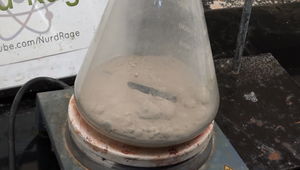Iron(II) chloride
 Anhydrous FeCl2
| |
| Names | |
|---|---|
| IUPAC name
Iron(II) chloride
| |
| Other names
Ferrous chloride
Iron dichloride Rokühnite | |
| Properties | |
| FeCl2 | |
| Molar mass | 126.751 g/mol (anhydrous) 198.8102 g/mol (tetrahydrate) |
| Appearance | White solid (anhydrous) Green solid (hydrated) |
| Odor | Odorless |
| Density | 3.16 g/cm3 (anhydrous) 2.39 g/cm3 (dihydrate) 1.93 g/cm3 (tetrahydrate) |
| Melting point | 677 °C (1,251 °F; 950 K) (anhydrous) 120 °C (248 °F; 393 K) (dihydrate) 105 °C (221 °F; 378 K) (tetrahydrate) |
| Boiling point | 1,023 °C (1,873 °F; 1,296 K) (anhydrous) |
| 64.4 g/100 ml (10 °C) 68.5 g/100ml (20 °C) 105.7 g/100 ml (100 °C) | |
| Solubility | Soluble in acetone, ethanol, methanol, THF Slightly soluble in benzene, dioxane, toluene Insoluble in chloroform, diethyl ether, pentane |
| Vapor pressure | ~0 mmHg |
| Hazards | |
| Safety data sheet | Sigma-Aldrich (anhydrous) Sigma-Aldrich (tetrahydrate) |
| Flash point | Non-flammable |
| Related compounds | |
| Related compounds
|
Iron(III) chloride |
| Except where otherwise noted, data are given for materials in their standard state (at 25 °C [77 °F], 100 kPa). | |
| Infobox references | |
Iron(II) chloride or ferrous chloride, is a salt of iron with the formula FeCl2.
It exists in nature as the rare mineral Rokühnite (FeCl2·2 H2O).
Contents
Properties
Chemical
Ferrous chloride will slowly oxidize in air to ferric oxide and ferric chloride.
Physical
Ferrous chloride is a white (anhydrous) or green (hydrated) solid, soluble in water.
Availability
Iron(II) chloride is sold by chemical suppliers.
Preparation
Ferrous chloride can be prepared by reacting hydrochloric acid with iron metal. If you want to obtain the solid form, you will have to dry it in the presence of excess iron, in low oxygen environment.
NurdRage has a procedure on making this compound.
Projects
- Catalyst in organic chemistry
- Grow beautiful crystals
Handling
Safety
Ferrous chloride is sensitive to air.
Storage
In air-tight containers.
Disposal
Should be mixed with a base, dried and dumped in trash or strongly diluted and poured down the drain.